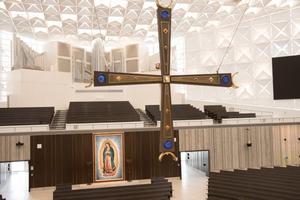Gothic Revival Reborn: Nottingham Cathedral Interior to Be Restored ‘to Its Original Glory’
‘Restore Pugin’ grant will refurbish the work of Augustus Welby Northmore Pugin, who also worked on London’s clock tower — home of ‘Big Ben’ — and the Houses of Parliament.

He reignited the dazzling colors, details and diversity of the Middle Ages with his buildings. Now, his design of a Catholic church that brings to life this legacy — St. Barnabas Cathedral in Nottingham, England — is to be restored and brought back to life.
Augustus Welby Northmore Pugin famously worked on iconic buildings such as London’s clock tower — which houses “Big Ben” — and the Houses of Parliament. At Nottingham Cathedral, built in the 1840s, Pugin pioneered a revival of the grand tradition of medieval architecture known as Gothic Revival.
With the support of money from British lottery players, the “Restoring Pugin” project aims to revive this heritage in England’s East Midlands in the heart of Nottingham city center on busy Derby Road.
The project has received the offer of a substantial grant from the National Lottery Heritage Fund to fulfill its goal.
The development grant awarded amounts to £277,558 (more than $312,000). That pays for some 60% of project development costs, according to a statement by the Bishops’ Conference of England and Wales.
There is also a potential delivery grant of £524,858 (more than $591,000) for the implementation phase, covering 60% of the project’s total cost of restoring the Grade II* listed building.
“This is a really exciting project,” said Sophie Andreae, vice chair of the Bishops’ Conference’s Patrimony Committee.
“The original Pugin decorative scheme in Nottingham Cathedral would once have filled the building with color, contributing greatly to the sense of the sacred,” she said.
“Following a number of grants in recent years, which have seen the exterior of the cathedral made wind- and water-tight, now is the time to focus on [the] interior and to restore it to its original glory,” Andreae continued. “The original painted decoration is there under layers of later paint just waiting to be revealed.”
Benachir Medjdoub, professor of digital architecture at Nottingham Trent University, said the project is an opportunity to use the latest restoration tools.
“This project will use advanced digital technologies and real-time data to pave the way to new pedagogical tools to educate our young people from different communities in heritage and conservation and to support Nottingham Cathedral conservation through real-time monitoring,” he said.
The recent lottery grant made possible a laser scan and a fly-through model of the cathedral. The 3-D model shows the original building and Pugin’s original designs.
Since the U.K.’s National Lottery began in 1994, National Lottery players have raised more than £43 billion for projects, and more than 635,000 grants have been awarded across Great Britain and Northern Ireland.
“We are really delighted that the National Lottery Heritage Fund is generously supporting our plans to ‘Restore Pugin’ at Nottingham Cathedral,” Canon Malachy Brett, dean of Nottingham Cathedral, said in a statement.
“Thanks to National Lottery players, not only will we be able to restore some of Pugin’s magnificent original design work to the cathedral but [we will also be able] to create a number of opportunities for young people to engage in conservation and heritage work.”
- Keywords:
- cathedrals
- england
- church restoration

















